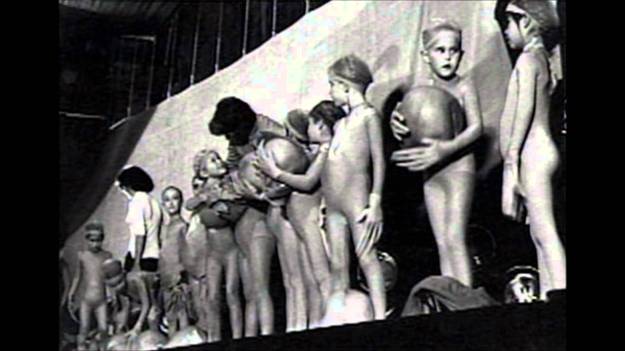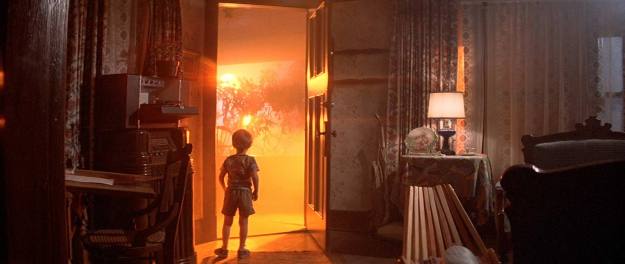According to a classification system that goes unexplained in the film, a close encounter of the first kind would be a UFO sighting. The second kind is finding proof of alien life. The third kind, as you likely know, is making actual contact with aliens themselves. A fourth kind has since been named and might have applied had Spielberg known of it; the fourth involves alien abduction.
Close Encounters very nearly featured what would have been early attempts at CGI. Director Steven Spielberg hired animator Colin Cantwell to create a CGI test of three UFOs floating over a stadium. The single-shot test took three whole weeks to complete, which immediately ruled it out in terms of the film, but it was one of the first computer generated images ever created for a film.
Spielberg’s next idea was even crazier. He wanted his aliens to have a gliding mobility (easily distinguished from human bi-pedal walking). So the obliging production team rigged up a grey spandex suit, slapped it on an orangutan, and put that orangutan on roller skates. What could go wrong? Well, turns out, it was a pretty smart monkey who knew a bad idea when it was strapped to his feet, so he sat down, removed the skates, and deliberately crawled to his handler.They never even got a screen test out of him.
After the monkeys came the mimes: they filmed the aliens mingling among human technicians played by mimes moving in slow motion so that when the film was sped up, the aliens appeared to be moving really fast while the technicians appeared to be moving at normal speed. They scrapped this too.
Finally the resorted to kids. It’s 6 year old elementary school girls (who move more gracefully than boys, Spielberg thought) in those costumes made especially for them and heavily backlit to achieve the proper silhouette. Cinematographer Vilmos Zsigmond overexposed the scenes so they would appear fuzzy and diffuse, and this helps them not look like little girls in rubber suits. Although, some of the shots in the climatic scenes are miniatures: the bright light coming out of the ship was created by a set of Christmas lights strung up on the back of a metal plate, behind little tiny alien figures. This was composited into a shot with real-life actors.

A special 9-foot version of the mothership was built for that one spindly-legged alien which appears briefly, spreading its arms in a peaceful gesture. That was a marionette prototype made by puppeteer Bob Baker. The marionette idea was nixed but “Daddy Long Legs” made it into the film.
But what about that final farewell where the alien signs the musical notes back to the humans? For that, Spielberg recruited a special effects artist by the name of Carlo Rambaldi who created a fully articulated steel, aluminum, and fiberglass animatronic puppet that Spielberg nicknamed “Puck.” Puck’s expressions were based on photos of Cary Guffey, the child actor who plays little Barry. The puppet was operated by a crew of seven puppeteers, with Spielberg himself controlling the final articulation before the alien leaves to go to the mothership.

Greg Jein
Incidentally, the aliens were meant to appear to be floating around in their ship, it being zero gravity or thereabouts. Even Roy was supposed to be seen to float into it as he approached. But the crew just couldn’t hide that many wires. They did, however, achieve weightlessness for Richard Dreyfuss in an early scene in his pick up truck. the truck was put on a turntable and flipped 360 degrees!
[During filming, Spielberg kept ruminating on Puck and wondered “What if this little guy didn’t get back on the mothership?” – that, of course, was the germination of E.T., whom Rambaldi would also go on to design.]
A note on those musical notes, which aren’t really a practical effect per se, but are such an iconic but humble sequence, we can’t not talk about composer John Williams’ brilliance for just a moment. Williams and Spielberg worked together a year before shooting even began to make sure they had the perfect sequence. Williams was originally working with 7 notes but since they wanted a simple greeting, they pared it down to 5 notes. Williams whipped up 100 permutations based on the Solfège system of musical education and together they whittled it down. Tuba player Jim Self is the “musical voice” of the mothership in the final edit.
A second note on how to get a great performance out of little Cary Guffey who’d never acted before. Spielberg has of course gone on to work with loads of child actors, but Guffey is among the youngest. Spielberg would unwrap presents just out of view of the camera so that Guffey would smile and point (you can also hear him excitedly shout “Toys! Toys!”). To get him to show fear, he had two crew members dress up in costumes. A false cardboard wall would drop, revealing a clown, and the poor kid would frown in surprise. Then a second wall drops, revealing a gorilla, and that was pretty scary. So the gorilla whips off his mask, revealing friendly makeup man Bob underneath and ta da – you got yourself a performance, or at least a series of emotions that look very real on tape.
Douglas Trumbull was the visual effects supervisor on Close Encounters of the Third Kind who came up with techniques for this film that would lead to advances in motion control photography, which is how you combine pictures of miniatures with pictures of full-scale elements.
The mother ship was designed by Ralph McQuarrie and built by Greg Jein. Its aesthetic was inspired by an oil refinery Spielberg saw at night in India. Instead of the metallic hardware look used in Star Wars, which was coming out the same year, they emphasized a more light-heavy, luminescent look for the UFOs (Dennis Muren, who’d just finished up with Star Wars, put a tiny R2-D2 on the underside of the mothership). One UFO model was an oxygen mask with lights attached to it. They experimented with all kinds of ordinary objects that had interesting shapes. The miniatures were filmed in dark, smoke-filled rooms so their lights would cut through the fog and look super cool.
Douglas Trumbull created the cloud effects by injecting white paint into tanks half filled with salt water and half filled with fresh water.

When asked in 1990 to select a single “master image” that summed up his film career, Spielberg chose the shot of Barry opening his living room door to see the blazing orange light from the UFO. “That was beautiful but awful light, just like fire coming through the doorway. [Barry’s] very small, and it’s a very large door, and there’s a lot of promise or danger outside that door.”



Brilliant history!
LikeLiked by 1 person
Thanks. I read the novelization when I was a little girl and read absolutely everything, but had to wait to be old enough to see the movie. I rewatched it with Sean recently and thought a lot about how they were achieving this stuff in the 70s.
LikeLiked by 1 person
Filmmakers used to have to be clever to achieve effects.
LikeLiked by 1 person
Yes and we were better for it!
It made them use them sparingly.
But we also saw the scary stuff less, which made it somehow worse when we did – it meant more.
LikeLiked by 1 person
What a marvelously interesting post! I now what I’m going to watch this weekend!
LikeLiked by 1 person
I found it on Amazon Prime, if that helps!
LikeLiked by 2 people
Thanks! That will save me digging through a ton of movies. I’ve every confidence that it’s shoved into the BACK of the entertainment center!
LikeLike
I love this behind the scenes information! Thanks for pointing it out.
LikeLiked by 1 person
What an amazing post this was! So much history on one of my favorite movies, and pretty much all of it I never knew about. These days all we have are CGI special effects, but as impressive as some of those are, I have always liked the (often more ingenious) practical effects. Really enjoyed reading this, thanks for sharing it! 😊
LikeLiked by 1 person
I have the blu ray and still have yet to see this. lol Might have to bump it up the list.
LikeLiked by 1 person
Wonderful film and a great film. I don’t think you can beat Spielberg in the 80s.
LikeLiked by 1 person
Loved this film, and didn’t know any of this, great information!
LikeLiked by 1 person
My husband loves pointing things out like the little RT-D2 on the ship in Close Encounters and how a sliding door in Star Wars actually hits a storm trooper in the head as he comes into the room and how Kubrick did the “plucking the pen out of the air” effect in 2001, etc. I didn’t know about (and neither did he, apparently) how they got the acting out of Cary or that the early alien attempts included putting a monkey on skates. Can’t wait to tell him that!
LikeLiked by 2 people
It was such an exhilarating decade if you were a SF fan … a bit like now, but for different reasons … but no matter what decade, it’s all in the visuals. 😀
LikeLiked by 1 person
Oh, that was lovely. One of my very bestest, very favorite childhood movies that I still adore. Thank you for that FASCINATING movie-lore, Jay.
LikeLiked by 1 person
Your post is the only thing I’ve ever enjoyed connected to that movie, in spite of my love for most fantasy
LikeLike
An excellent post Jay. Love me some Spielberg.
LikeLike
Very interesting! 🙂
LikeLike